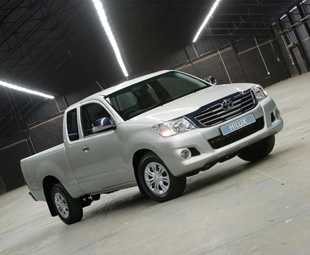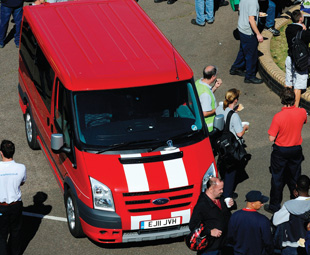Lightweight bout

The world of commercial vehicles stretches far and wide. No matter where you are on the planet, there is a need for some form of “light” commercial transportation. GAVIN MYERS explores the dynamics of this important segment.
Extra-heavy, heavy, medium and light … we know them well. In the commercial vehicle industry, emphasis is all too often placed on the former, with light commercial vehicles (LCVs) left to play a smaller role. But, the world over, these little workhorses are as popular as it gets for every reason. In America, for example, the current best-selling “truck”, as they call them, is Ford’s F-150 pick up – it’s held the title for 34 years. For 24 years, it was the best selling vehicle in the USA. Over 34-million Ford F-series vehicles have been sold over 12 generations since 1948.
Down under, they have their own idea of such a vehicle – called the ute (shortened from utility, originally coupe utility). The story goes that in 1932 a farmer’s wife wrote to Ford asking for a suitable enough vehicle for her and her husband to “go to church in on a Sunday and which can carry our pigs to market on Mondays …” The result was the 1934 Ford Coupe Utility – and today we have the Aussies to thank (luckily this isn’t cricket or rugby) for creations such as the Chevrolet Lumina Ute we reviewed in February. A case could even be made for the venerable Nissan 1400 bakkie and others of its ilk, with their cabins and integral load bay, to be considered as “utes”.
Over in Europe, the best selling commercial vehicle, and by far the most renowned, is the Ford Transit range of vans and people carriers. The Transit family has been around in three basic generations since 1965, in which time more than six million have been produced. In 2007, the Transit was named International Van of the Year.
 That’s the wonderful thing about the humble little LCV – it’s so versatile, with a multitude of interpretations to fit a multitude of purposes. Take a gander at any manufacturers’ catalogue: you’ll find the same basic vehicle adapted for a wide range of different tasks. Bare-bones basic panel vans, people carriers with varying degrees of luxury, and multi-cabs are your three basic options, with multi-cabs being the latest trend in the world of the van.
That’s the wonderful thing about the humble little LCV – it’s so versatile, with a multitude of interpretations to fit a multitude of purposes. Take a gander at any manufacturers’ catalogue: you’ll find the same basic vehicle adapted for a wide range of different tasks. Bare-bones basic panel vans, people carriers with varying degrees of luxury, and multi-cabs are your three basic options, with multi-cabs being the latest trend in the world of the van.
Likewise, a while ago, all we had was the humble single cab bakkie. Double cabs then became all the rage because of their dual-purpose nature. More recently, the super cab has emerged – a sort of cab-and-a-half for those requiring a slightly larger load bay than a double cab’s and slightly more cab space than a single cab provides.
Things get a little more complicated when it comes to the all-important GVM (gross vehicle mass) rating – these vary greatly in the LCV sector, anything right up to 3 500 kg, at which point you cross into the medium commercial vehicle (MCV) segment.
Decisions, decisions
There are currently 49 individual LCV models from 16 manufacturers on the market in South Africa. The biggest-selling of these is the Toyota Hilux; it has been for as long as it’s been on sale. The National Association of Automobile Manufacturers South Africa (Naamsa) reported 3 384 local Hilux sales in February this year, nearly twice that of the newly-launched Chevrolet Utility (1 846) which held second place in terms of LCV sales (see box). In fact, the Hilux was the biggest-selling vehicle in the country that month.
Noting the country’s five top-selling LCVs, it’s interesting that the Toyota Quantum is the only van-type model on the list – perhaps typical of us bakkie-mad South Africans. Unfortunately, Naamsa does not give a break-down of specific models.
 When contemplating the purchase of an LCV – be it a bakkie, van or people carrier – one needs to consider what it will be used for. There are many options: 4×2 or 4×4, petrol or diesel, manual or automatic, covered or open; and will it be used for purposes other than work? With the dual-purpose nature of most of these vehicles – many are used for daily transport as well as leisure – an uninformed decision can lead to an unsatisfactory purchase.
When contemplating the purchase of an LCV – be it a bakkie, van or people carrier – one needs to consider what it will be used for. There are many options: 4×2 or 4×4, petrol or diesel, manual or automatic, covered or open; and will it be used for purposes other than work? With the dual-purpose nature of most of these vehicles – many are used for daily transport as well as leisure – an uninformed decision can lead to an unsatisfactory purchase.
Take Sam*, an entrepreneur who runs a fleet of petrol-engined vans from a certain manufacturer. Sam decided to upgrade his personal van to something much bigger and pass his old faithful on to an employee. But his new vehicle failed to deliver.
Sam bought the vehicle because it was capable of having a full mobile workshop installed in the back. “But the fuel consumption is terrible,” he says. “This vehicle has cost me a fortune!”
Sam says he’s never been so unhappy with a vehicle. Unfortunately, he didn’t do the required homework other than looking at what he was getting for his money in terms of payload. He also has an aversion to diesel-engined vehicles as staff generally don’t look after them properly (which, as many could testify, is fair enough). However, since Sam was buying a van for his personal use and not necessarily for his fleet – also remembering it is constantly lugging a large load – a diesel-powered vehicle would certainly have been a better choice.
Bearing East
Good trade relations and the easing of import restrictions has led to a plethora of new entrants on the local market – makes and models we hadn’t even heard of 10 years ago, such as Tata and Mahindra from India, and Foton, GWM, CMC, JMC from China, together with Changan (which imports the Chana and DFSK brands from China) – the list goes on, and more are sure to come.
Why is South Africa such a hub of activity for these new entrants? Is it that we are a dumping ground? Teresita van Gaalen, chief executive of Changan Southern Africa, says this is not the situation. However, she does concede that there may be a correlation between dumping and volume. “China has a market of over 1,5-billion people, so the notion of volume and the possible mistaken perceptions of ‘dumping’ (as it relates to quantity) is almost to be expected,” she says.
“There is a fit for Asian products in African markets if we accept that the focus of these brands is mostly on affordability, accessibility and simplicity – built up on a volume-based model,” continues Van Gaalen. “On the other hand, the Chinese models available here are current in China and other parts of the world.”
Be that as it may, there is always the issue of the quality of these products – again, especially those from China. “In the early days of Japanese vehicles coming to SA, the same type of statements categorised them as sub-standard,” notes Van Gaalen. “I don’t doubt that tomorrow Chinese vehicles will be seen in the same light that Japanese vehicles are today. To change negative perceptions, we need more open conversation; we need to continuously stimulate informed opinions – this industry needs more open debate,” she stresses.
If this is true, how soon will that tomorrow come, and what exactly does Van Gaalen – who aims for Changan to achieve a five percent market share in five years’ time – see happening in the LCV segment over the next few years?
For the bigger picture, she suggests using the perspective of the global increase in trade with China and the pace at which it has been realised: “China became South Africa’s biggest trading partner in 2009, when total trade between the two countries amounted to R119,5 billion,” she says.
“So I see a revolution – with increased volumes and demand outstripping supply in a highly stimulated SMME-driven economy.”
Van Gaalen says the recent re-introduction of DFM under the DFSK banner and the imminent arrival of FAW mini trucks under the Imperial banner and the Indian Tata sub-tonne fleet pay testimony to the situation.
“It’s exciting to see this explosion of product and revitalised competition through growth and expansion in the LCV sub-segment.”
* Not his real name.
Published by
Focus on Transport
focusmagsa



